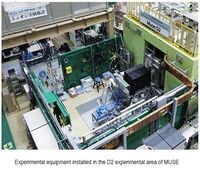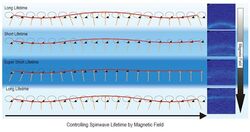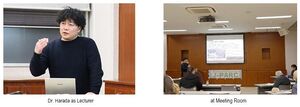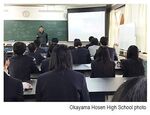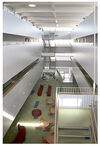J-PARC News February 2024 (Issue #226)
■Press Study Session Held (January 26)
The J-PARC main ring has achieved a 20-year-long ambition since the inception of the project: the continuous supply of 760 kW beams to the Neutrino Experimental Facility. Efficient recovery and reuse of energy stored in electromagnets have contributed to a 1.5-fold increase of supply in beam power with the same power consumption, resulting in significant energy savings. The T2K Experiment International Research Group has enhanced the neutrino generator, realizing the production of a record number of neutrinos per unit of time. J-PARC conducts the T2K experiment to investigate the fundamental properties of neutrinos, elementary particles. While Japan's neutrino research is already at the world's top level with two Nobel laureates, the T2K experiment is expected to make a substantial leap forward with this increased beam power, leading to generating new results toward the subsequent Hyper-Kamiokande project, ahead of the world.
The information above was introduced in a press release on January 17, and a press study session was held at the J-PARC center on this topic. The session included explanations from Dr. Susumu Igarashi of the Accelerator Division and Dr. Ken Sakashita of the Particle and Nuclear Physics Division. A tour of the facilities, including Central Control Building, Neutrino Monitoring Building, and Primary Proton Beamline, was also conducted. The details introduced during this study session were later published in newspapers and other media.
For more information, please visit the J-PARC website.
(1) Significant Increase in Beam Power and Electric Power Efficiency of the J-PARC Main Ring Accelerator - A Powerful Driving Force for Neutrino Research -
https://j-parc.jp/c/en/press-release/2024/01/17001276.html
(2) T2K experiment enters a new phase with significantly improved sensitivity for its world leading neutrino oscillation research - Started data taking with upgraded accelerator neutrino beam and new detectors -
https://j-parc.jp/c/en/press-release/2024/01/17001274.html
■Precision Spectroscopy Measurements of Muonic Helium Atoms — World record improved for the first time in 40 years —
A collaborative research team from KEK, J-PARC, Nagoya University, and the University of Tokyo succeeded in measuring the hyperfine structure of muonic helium atoms using the Muon Science Facility (MUSE) D-line at MLF of the J-PARC. The result is 1.5 times more precise than the previous measurement, meaning the establishment of a highly precise method using pulsed muons for the first time in the world.
A muonic helium atom, which is composed of an ordinary helium atom with one of its two electrons replaced by a negative muon, is a special atom that is not found in nature. Precision spectroscopy measurements of the muonic helium atom hyperfine structure can be used not only to determine the mass of the negative muon but also to examine CPT invariance, which is a fundamental theory of physics, by comparing the masses of positive and negative muons. The technique will be applied at the H-line, providing ten times higher muon beam intensity and longer measurement time, enabling 100 times more precise measurement of the mass of negative muons. Based on this experiment, continuous measurement of the hyperfine structure of muonic helium atoms may make it possible to unveil the difference in nature between particles and antiparticles.
For more details, please visit the J-PARC website.
https://j-parc.jp/c/en/press-release/2023/12/28001264.html
■Successful Control of Spin-Wave Life Time in Quantum Magnet by Magnetic Field
- Possibility of Switching Device for Spin-current control -
A research team from the University of Tokyo, KEK, and J-PARC has successfully controlled the spin-wave life time in a quantum antiferromagnet RbFeCl3 for the first time in the world.
The team measured spectra of spin waves in RbFeCl3 under various magnetic fields using the High Resolution Chopper Spectrometer HRC at MLF of the J-PARC, the Cold Neutron Triple-Axis Spectrometer HER installed in JRR-3, and the Hybrid Spectrometer HYSPEC at the Spallation Neutron Source in Oak Ridge National Laboratory. As a result, it was found that well-defined spin waves observed without magnetic fields are decayed under low magnetic fields due to dissipation of spins, and have long life time again under high magnetic fields. These findings demonstrate that spin-wave life time can be controlled by magnetic fields.
Spin currents exist even in insulators and are paid attention to as currents without energy loss. The findings in this study suggest that a quantum magnet can be utilized as a switching device to control spin currents, if a quantum magnet controlling the spin-wave life time in energies corresponding to thermal energies at room temperature by magnetic fields is found. From a closer view of point, the research of control of spin-wave life time by magnetic fields is expected to be promising by further improvements of neutron spectroscopy.
For more details, please visit the J-PARC website.
https://j-parc.jp/c/press-release/2024/01/11001267.html (only in Japanese)
DOI: 10.1038/s41467-023-44435-0
■Successfully Developing New Mirror-Based High-Precise Neutron Interferometer
- Achieving Precise Measurement of Neutron-Nuclear Scattering -
A collaborative research team from RIKEN, Nagoya University, KEK, J-PARC Center, and Kyoto University has successfully developed a novel neutron interferometer to precisely measure the neutron interactions with significantly enhanced sensitivity compared to conventional methods.
Neutron interferometers, using quantum characteristics, have been utilized in various physics experiments, such as material analysis, due to their ability to precisely measure neutron-related reactions. However, their sensitivity improvement has been constrained by challenges in beam control and experimental limitation.
The research group focused on controlling a neutron beam utilizing "multilayer neutron mirror" that allows flexible adjustment of the wavelength of reflected neutrons. The four mirrors necessary for the interferometer were individually manufactured, allowing flexible adjustment of their positions based on the experimental requirements. Furthermore, the multilayer neutron mirror's ability to use a wider range of neutron wavelengths compared to crystals has improved neutron usage efficiency, simplifying stabilization mechanisms like vibration isolators due to reduced measuring time.
The experiment for interference fringe was conducted at MLF of the J-PARC, successfully observing interference fringe depending on neutron wavelength for the first time. Since interference fringes produced by the repeated flight of pulsed neutrons following time changes can be observed, time-dependent noises can be removed from the observed data. Future development will enable further improvement in accuracy by optimizing wavelength utilization and increasing the size of the instrument.
The interferometer works on the novel principle of obtaining interference fringes for various neutron wavelengths. Compared to conventional instruments, the sensitivity has been greatly improved and it is now easier to handle. This advancement is expected to be applied to a variety of research fields, including the material science, nuclear and elementary particle physics, and the elucidation of the mysteries of the expanding universe.
For more details, please visit our website.
https://j-parc.jp/c/press-release/2024/01/13001268.html (only in Japanese)
DOI: 10.1103/PhysRevLett.132.023402
■Hyper-Kamikande Project Promotion Council Held (February 14)
The 4th Hyper-Kamiokande Project Promotion Council was held at J-PARC on February 14. The Hyper-Kamiokande Project is an international collaborative scientific initiative hosted by Japan. It aims to elucidate the origin of matter in the universe and the Grand Unified Theory of elementary particles. To realize that, the project involves constructing a large underground experimental facility, which consists of a water tank with an effective volume 8.4 times larger than that of the Super-Kamiokande detector, along with highly sensitive light sensors. Additionally, it will increase the number of neutrinos generated at J-PARC.
During the council, reports were provided on the progress of the Hyper-Kamiokande project, budget planning, and the status of agreements with international research organizations. The on-site council, held for the first time in four years, facilitated a lively exchange of opinions, confirming further collaboration between KEK and the University of Tokyo.
Following the conclusion of the council, participants had the opportunity to tour the facility and observe the upgraded Near Neutrino Detector for the T2K experiment.
■J-PARC Hello Science
“Thanks to ‘That’, High Intensity Proton Beam Accelerators Can Realize in the World” (January 26)
The lecturer of January's "Hello Science" was Dr. Hiroyuki HARADA from the Accelerator Division. What is "that" of accelerators? "That" means "the multi-turn charge exchange injection of negative Hydrogen ions", which is a crucial or key technique for the world proton beam accelerators including the J-PARC to intensify the beam power.
Mainly, beams are controlled by bending or converging the orbit using magnetic fields. On accumulating protons at ring accelerators such as synchrotrons or accumulators, the number of injections is limited in the case that injection particles are protons with positive charges. Because the particles with the same charges are bent in the same direction by the magnetic field excited in magnet, injected protons cannot merge to the orbit of proton beams already circulating in the ring accelerator. Then, utilizing negative Hydrogen ions, ions with two electrons for one proton, makes it possible to smoothly merge to the circulating proton beams with positive charges because negative charge ions can be bent to the inverse direction in the magnetic fields. By stripping electrons of negative Hydrogen ions by passing through carbon foils after merging positive and negative beams, beams consisting of only protons can be generated. This method enabled us to accumulate more protons and to realize the high intensity proton accelerators in the world.
However, increasing the number of particles in beams gives them new challenging issues to realize further high intensity proton accelerator. They are a short and expected lifetime of carbon foil by increasing damage/overheating and the high radioactivation of the injection equipment near the foil by increasing scattered particles at the foil.
So now, the accelerator group of the J-PARC is progressing with research and development of new technology to strip the electrons of the injection beams without carbon foils. This is the method of charge exchange from negative Hydrogen ions to protons with positive charges by stripping two elections of injection beams using Laser, foil less. Once we establish this technology, high intensity proton accelerators will accumulate and accelerate further beams. Please pay attention with expectations for evolving accelerators and the future cultivated by J-PARC going forward.
■Director Gives a Lecture at Okayama Housen High School in Okayama Prefecture (January 27th)
J-PARC Center Director Takashi Kobayashi delivered a lecture titled “Mystery of the Universe - Exploit through Accelerator and Neutrino". A total of 36 first-year and second-year students participated in the event, giving feedback such as "I realized how fun Physics is." and "I'd like to know the details about how different the character of the matter and anti-matter."
■J-PARC Sanpomichi ㊸ Research Building of J-PARC in Early Spring
![]() The entrance hall of the research building of J-PARC serves as a location for taking group photos of dignitaries and participants in international conferences. The hall extends as an open space up to the top floor, creating a soaring vertical atrium where sunlight, streaming through the glass entrance and skylights, naturally illuminates the faces of the subjects.
The entrance hall of the research building of J-PARC serves as a location for taking group photos of dignitaries and participants in international conferences. The hall extends as an open space up to the top floor, creating a soaring vertical atrium where sunlight, streaming through the glass entrance and skylights, naturally illuminates the faces of the subjects.
While the building is equipped with an elevator, some individuals prefer to use the stairs for health reasons. The staircase, protruding on the inside of the atrium, gives the impression of a floating staircase. On the second floor, one can enjoy a panoramic view of pine trees through the windows, and on the third floor, the peak of Mount Takasuzu in the Taga Mountain range becomes visible to the north. Upon reaching the fourth floor, the expansive Pacific Ocean unfolds to the east, while to the north, the foothills of the Taga Mountain range come into view.
From February to March, Tokai Village experiences a challenging season with lingering cold and airborne pollen, exacerbated by the direct impact of the spring breeze along the coast. Nevertheless, the robust early spring sunlight penetrates through the skylights and glass windows, gently warming and brightening the entire J-PARC research building from within.


